FORD F650 2004 11.G Owners Manual
Manufacturer: FORD, Model Year: 2004, Model line: F650, Model: FORD F650 2004 11.GPages: 264, PDF Size: 1.47 MB
Page 121 of 264
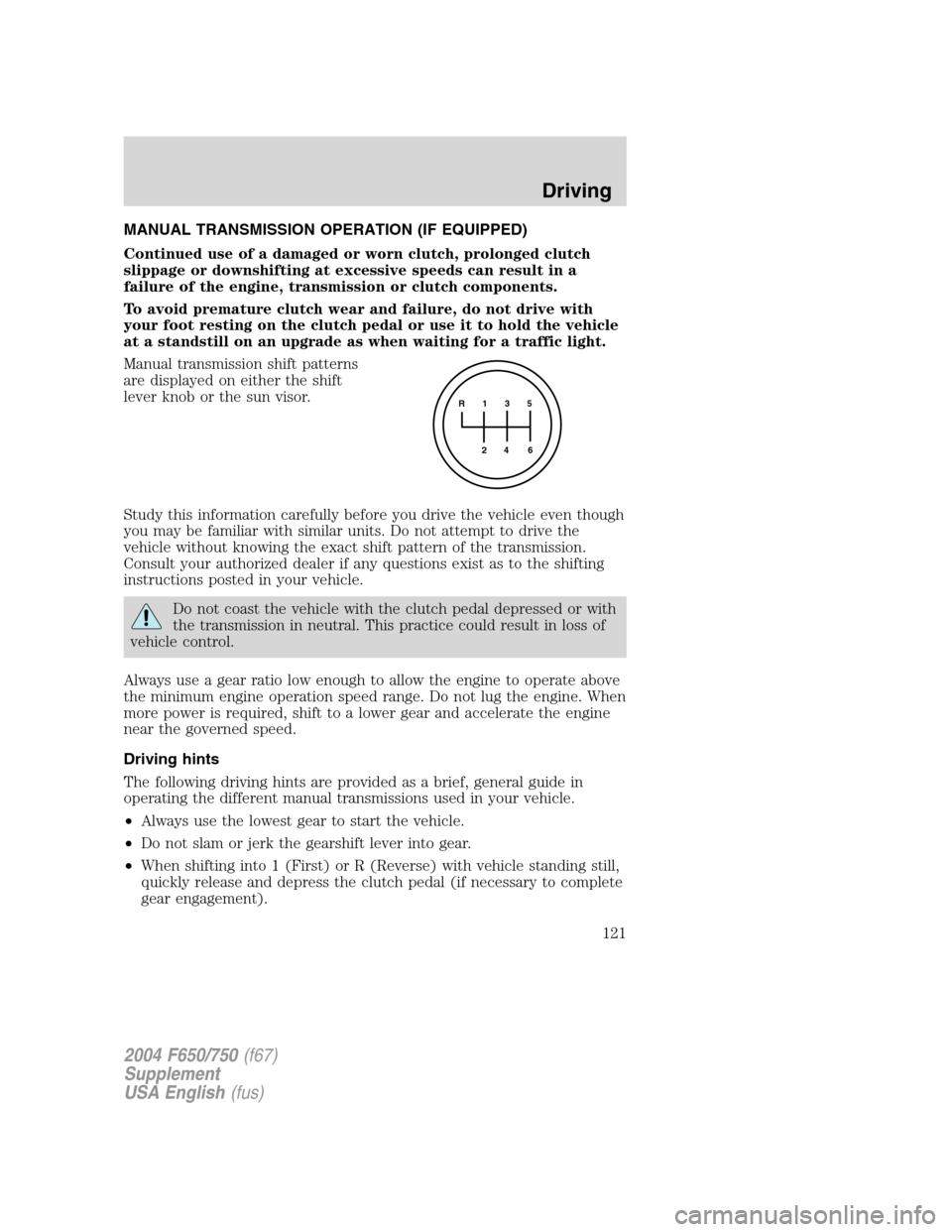
MANUAL TRANSMISSION OPERATION (IF EQUIPPED)
Continued use of a damaged or worn clutch, prolonged clutch
slippage or downshifting at excessive speeds can result in a
failure of the engine, transmission or clutch components.
To avoid premature clutch wear and failure, do not drive with
your foot resting on the clutch pedal or use it to hold the vehicle
at a standstill on an upgrade as when waiting for a traffic light.
Manual transmission shift patterns
are displayed on either the shift
lever knob or the sun visor.
Study this information carefully before you drive the vehicle even though
you may be familiar with similar units. Do not attempt to drive the
vehicle without knowing the exact shift pattern of the transmission.
Consult your authorized dealer if any questions exist as to the shifting
instructions posted in your vehicle.
Do not coast the vehicle with the clutch pedal depressed or with
the transmission in neutral. This practice could result in loss of
vehicle control.
Always use a gear ratio low enough to allow the engine to operate above
the minimum engine operation speed range. Do not lug the engine. When
more power is required, shift to a lower gear and accelerate the engine
near the governed speed.
Driving hints
The following driving hints are provided as a brief, general guide in
operating the different manual transmissions used in your vehicle.
•Always use the lowest gear to start the vehicle.
•Do not slam or jerk the gearshift lever into gear.
•When shifting into 1 (First) or R (Reverse) with vehicle standing still,
quickly release and depress the clutch pedal (if necessary to complete
gear engagement).
R 1 3 5
4
6 2
2004 F650/750(f67)
Supplement
USA English(fus)
Driving
121
Page 122 of 264
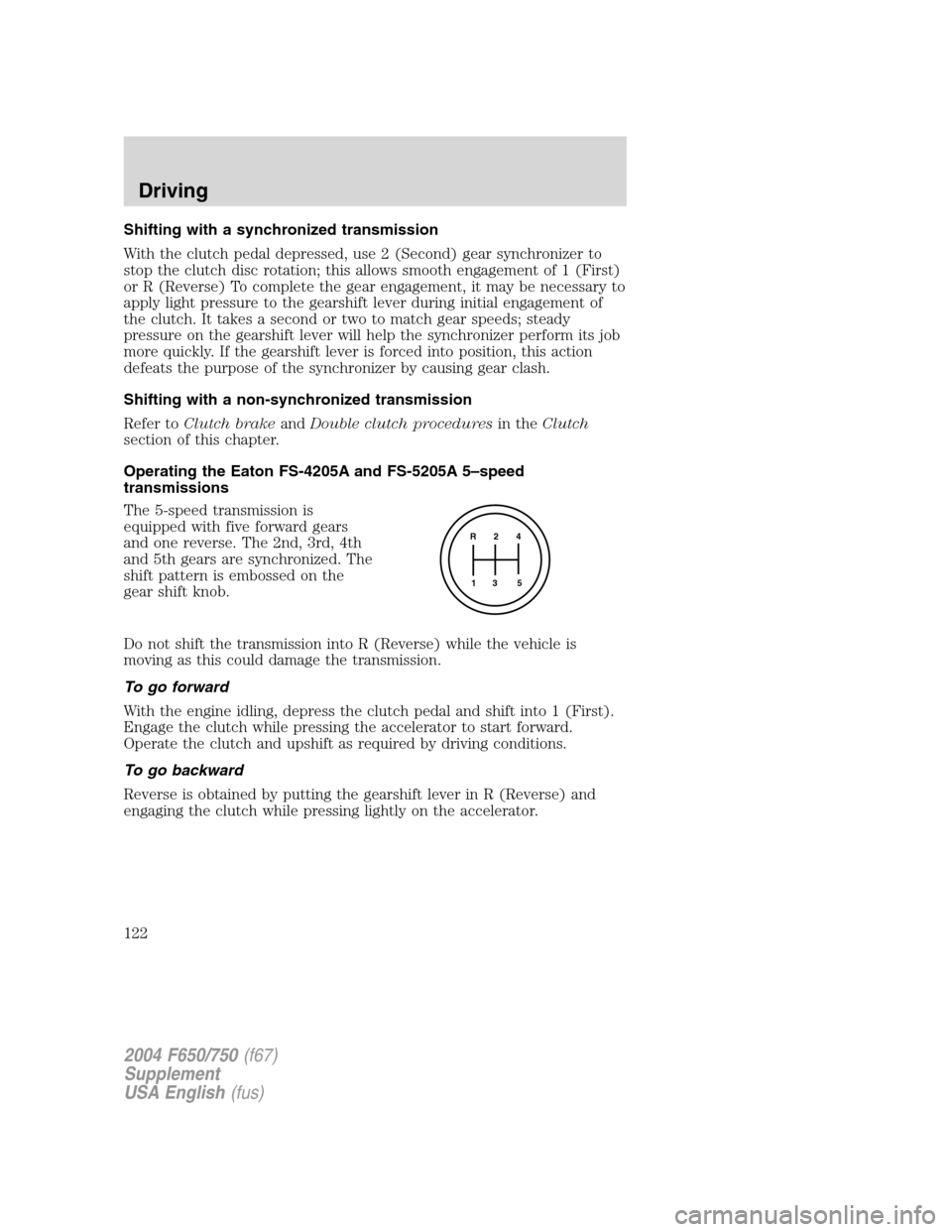
Shifting with a synchronized transmission
With the clutch pedal depressed, use 2 (Second) gear synchronizer to
stop the clutch disc rotation; this allows smooth engagement of 1 (First)
or R (Reverse) To complete the gear engagement, it may be necessary to
apply light pressure to the gearshift lever during initial engagement of
the clutch. It takes a second or two to match gear speeds; steady
pressure on the gearshift lever will help the synchronizer perform its job
more quickly. If the gearshift lever is forced into position, this action
defeats the purpose of the synchronizer by causing gear clash.
Shifting with a non-synchronized transmission
Refer toClutch brakeandDouble clutch proceduresin theClutch
section of this chapter.
Operating the Eaton FS-4205A and FS-5205A 5–speed
transmissions
The 5-speed transmission is
equipped with five forward gears
and one reverse. The 2nd, 3rd, 4th
and 5th gears are synchronized. The
shift pattern is embossed on the
gear shift knob.
Do not shift the transmission into R (Reverse) while the vehicle is
moving as this could damage the transmission.
To go forward
With the engine idling, depress the clutch pedal and shift into 1 (First).
Engage the clutch while pressing the accelerator to start forward.
Operate the clutch and upshift as required by driving conditions.
To go backward
Reverse is obtained by putting the gearshift lever in R (Reverse) and
engaging the clutch while pressing lightly on the accelerator.
R 2 4
3 5 1
2004 F650/750(f67)
Supplement
USA English(fus)
Driving
122
Page 123 of 264
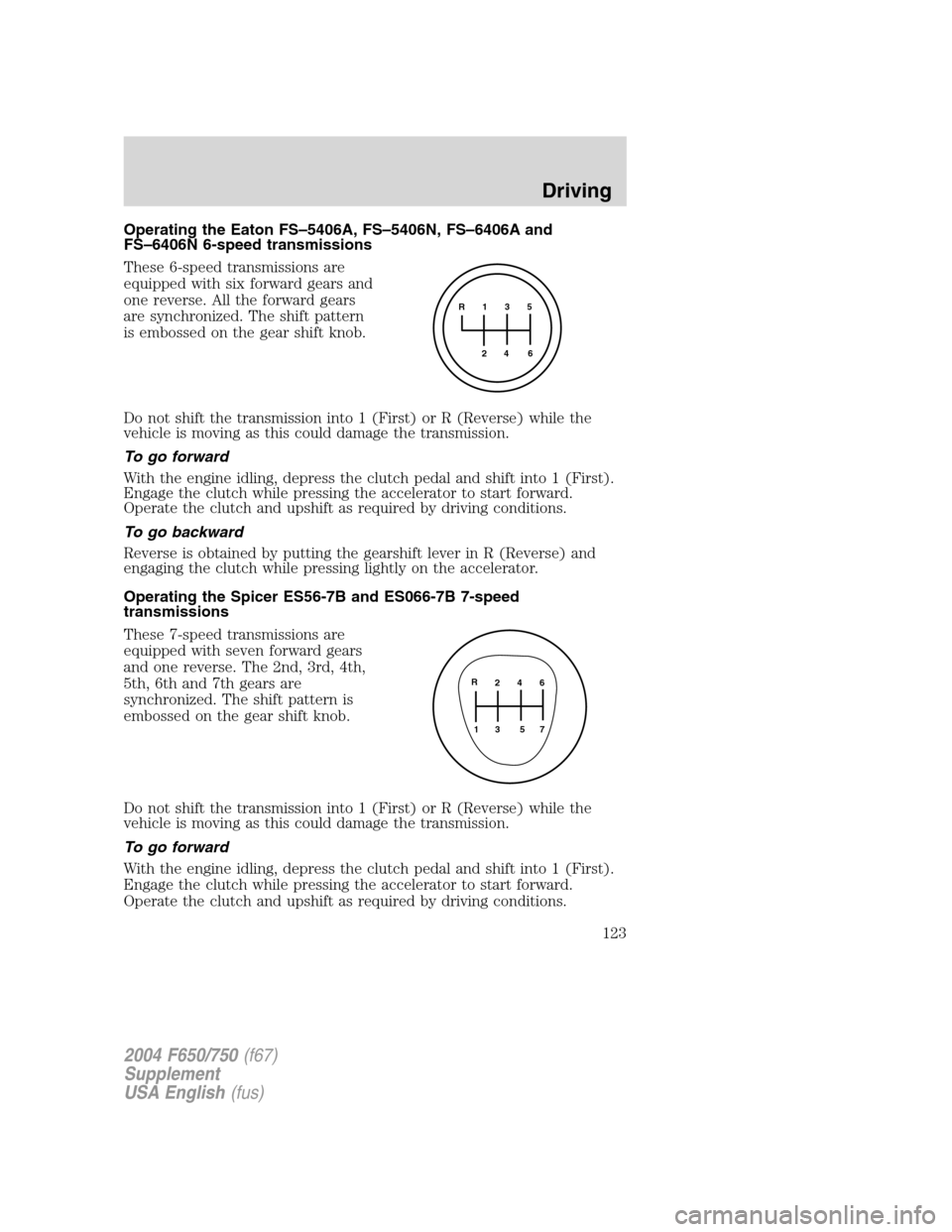
Operating the Eaton FS–5406A, FS–5406N, FS–6406A and
FS–6406N 6-speed transmissions
These 6-speed transmissions are
equipped with six forward gears and
one reverse. All the forward gears
are synchronized. The shift pattern
is embossed on the gear shift knob.
Do not shift the transmission into 1 (First) or R (Reverse) while the
vehicle is moving as this could damage the transmission.
To go forward
With the engine idling, depress the clutch pedal and shift into 1 (First).
Engage the clutch while pressing the accelerator to start forward.
Operate the clutch and upshift as required by driving conditions.
To go backward
Reverse is obtained by putting the gearshift lever in R (Reverse) and
engaging the clutch while pressing lightly on the accelerator.
Operating the Spicer ES56-7B and ES066-7B 7-speed
transmissions
These 7-speed transmissions are
equipped with seven forward gears
and one reverse. The 2nd, 3rd, 4th,
5th, 6th and 7th gears are
synchronized. The shift pattern is
embossed on the gear shift knob.
Do not shift the transmission into 1 (First) or R (Reverse) while the
vehicle is moving as this could damage the transmission.
To go forward
With the engine idling, depress the clutch pedal and shift into 1 (First).
Engage the clutch while pressing the accelerator to start forward.
Operate the clutch and upshift as required by driving conditions.
R 1 3 5
4
6 2
2 4 6
3 5 71 R
2004 F650/750(f67)
Supplement
USA English(fus)
Driving
123
Page 124 of 264

To go backward
Reverse is obtained by putting the gearshift lever in R (Reverse) and
engaging the clutch while pressing lightly on the accelerator.
Operating the Eaton 8908LL 10-speed transmission
These transmissions have five
forward speeds in the LO range, and
four forward speeds in the HI range.
These transmissions employ a Deep
Reduction Valve and control to allow
for a LO-LO gear operation for
adverse conditions. Study the
instruction plate on the sun visor
thoroughly and learn the shift
pattern of your transmission.
To go forward
With the engine idling, depress the clutch pedal and move the gearshift
lever to the neutral position.
Place the range selector in the LO
range and the Deep Reduction
Button in the OUT/REARWARD
position or,
place the Deep Reduction in the
IN/FORWARD position if you want
to start in LO-LO under adverse
conditions.
27
3
6
2 LO
LO-LO
8
4
R R
R R
5 1
1
Neutral
5
17
3
6
2 LO
LO-LO
8
4
R R
R
Neutral
5
17
3
6
2 LO
LO-LO
8
4
R R
R
Neutral
2004 F650/750(f67)
Supplement
USA English(fus)
Driving
124
Page 125 of 264
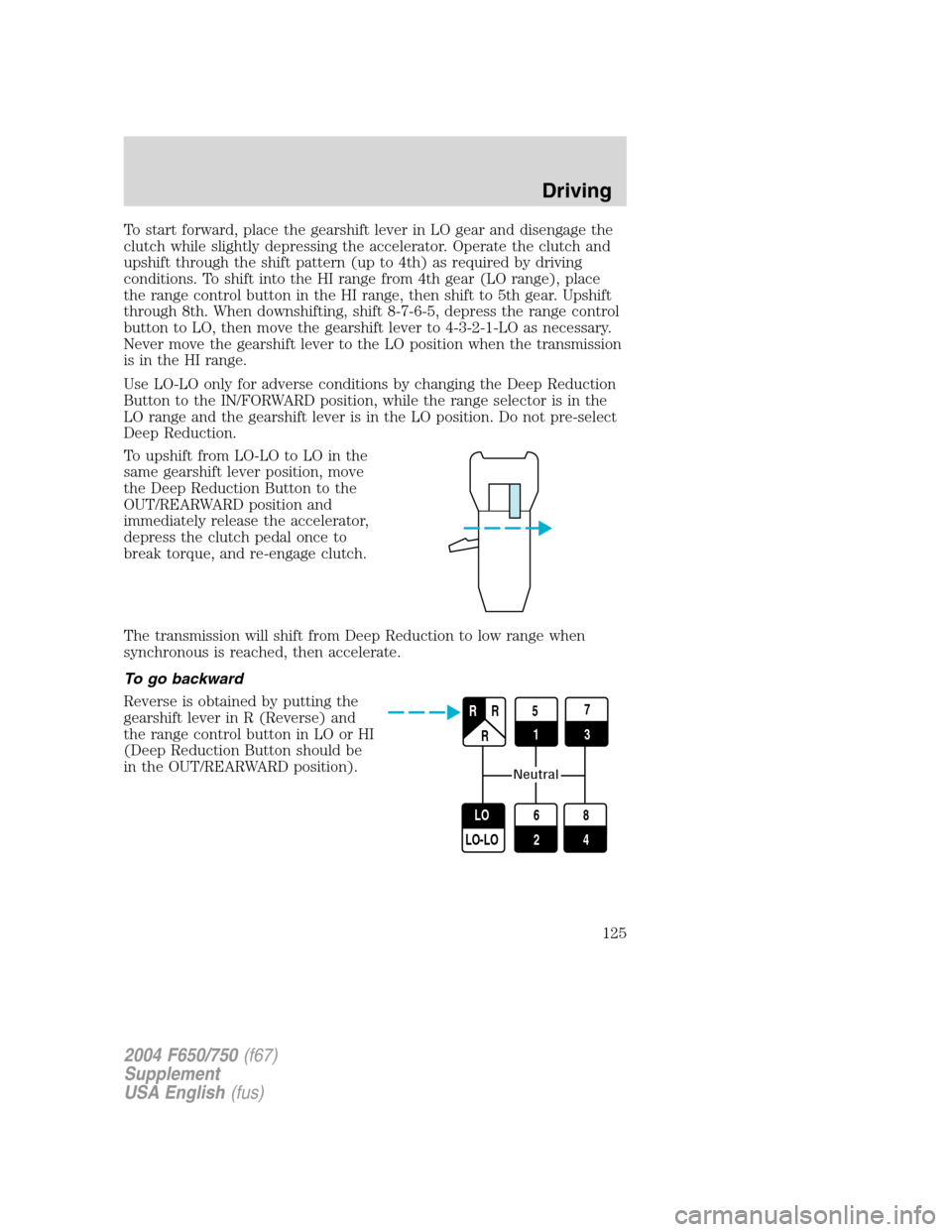
To start forward, place the gearshift lever in LO gear and disengage the
clutch while slightly depressing the accelerator. Operate the clutch and
upshift through the shift pattern (up to 4th) as required by driving
conditions. To shift into the HI range from 4th gear (LO range), place
the range control button in the HI range, then shift to 5th gear. Upshift
through 8th. When downshifting, shift 8-7-6-5, depress the range control
button to LO, then move the gearshift lever to 4-3-2-1-LO as necessary.
Never move the gearshift lever to the LO position when the transmission
is in the HI range.
Use LO-LO only for adverse conditions by changing the Deep Reduction
Button to the IN/FORWARD position, while the range selector is in the
LO range and the gearshift lever is in the LO position. Do not pre-select
Deep Reduction.
To upshift from LO-LO to LO in the
same gearshift lever position, move
the Deep Reduction Button to the
OUT/REARWARD position and
immediately release the accelerator,
depress the clutch pedal once to
break torque, and re-engage clutch.
The transmission will shift from Deep Reduction to low range when
synchronous is reached, then accelerate.
To go backward
Reverse is obtained by putting the
gearshift lever in R (Reverse) and
the range control button in LO or HI
(Deep Reduction Button should be
in the OUT/REARWARD position).
27
3
6
2 LO
LO-LO
8
4
R R
R R
5 1
1
Neutral
2004 F650/750(f67)
Supplement
USA English(fus)
Driving
125
Page 126 of 264
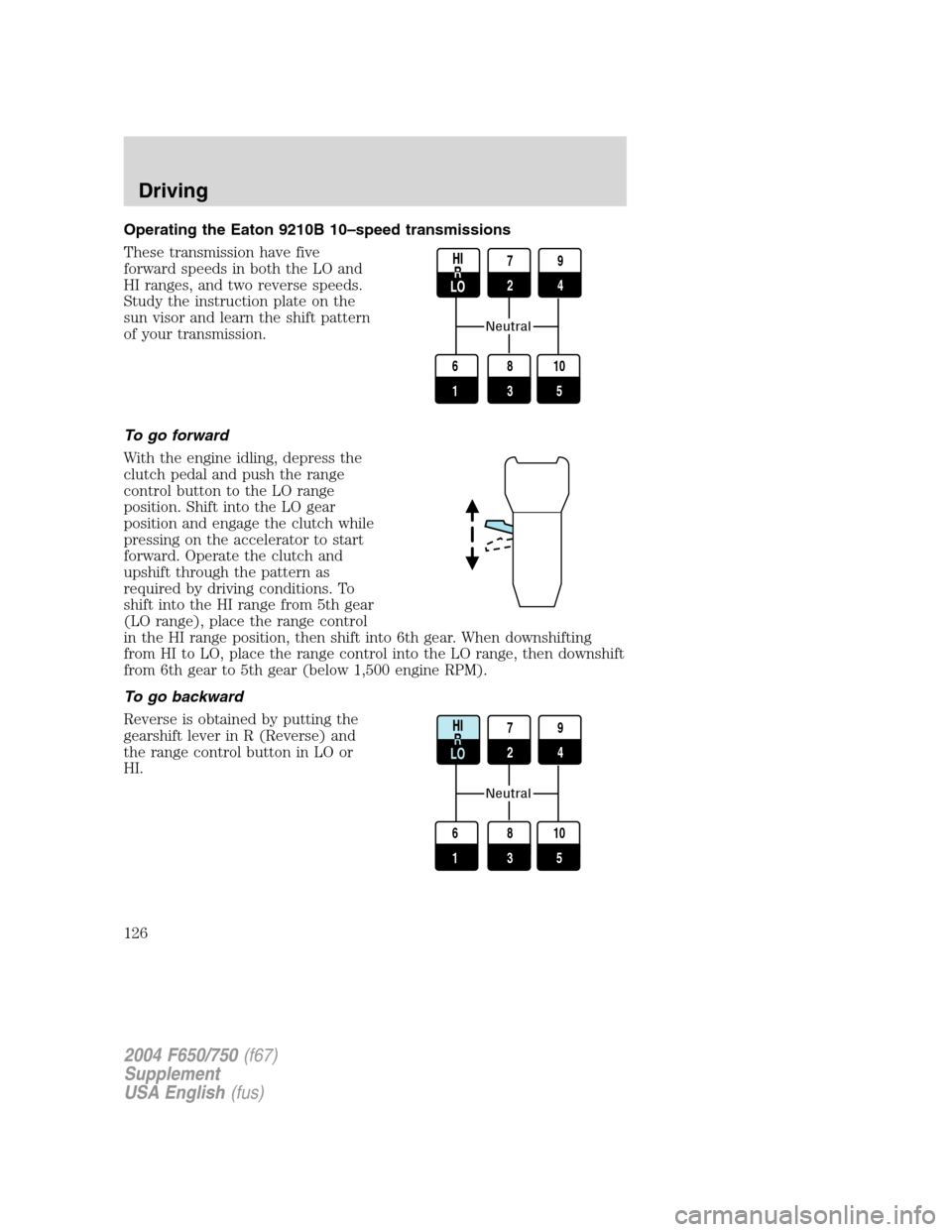
Operating the Eaton 9210B 10–speed transmissions
These transmission have five
forward speeds in both the LO and
HI ranges, and two reverse speeds.
Study the instruction plate on the
sun visor and learn the shift pattern
of your transmission.
To go forward
With the engine idling, depress the
clutch pedal and push the range
control button to the LO range
position. Shift into the LO gear
position and engage the clutch while
pressing on the accelerator to start
forward. Operate the clutch and
upshift through the pattern as
required by driving conditions. To
shift into the HI range from 5th gear
(LO range), place the range control
in the HI range position, then shift into 6th gear. When downshifting
from HI to LO, place the range control into the LO range, then downshift
from 6th gear to 5th gear (below 1,500 engine RPM).
To go backward
Reverse is obtained by putting the
gearshift lever in R (Reverse) and
the range control button in LO or
HI.
7
29
4
8
3 6
1
10
5
R
Neutral
7
29
4
8
3 6
1
10
5
R
Neutral
2004 F650/750(f67)
Supplement
USA English(fus)
Driving
126
Page 127 of 264
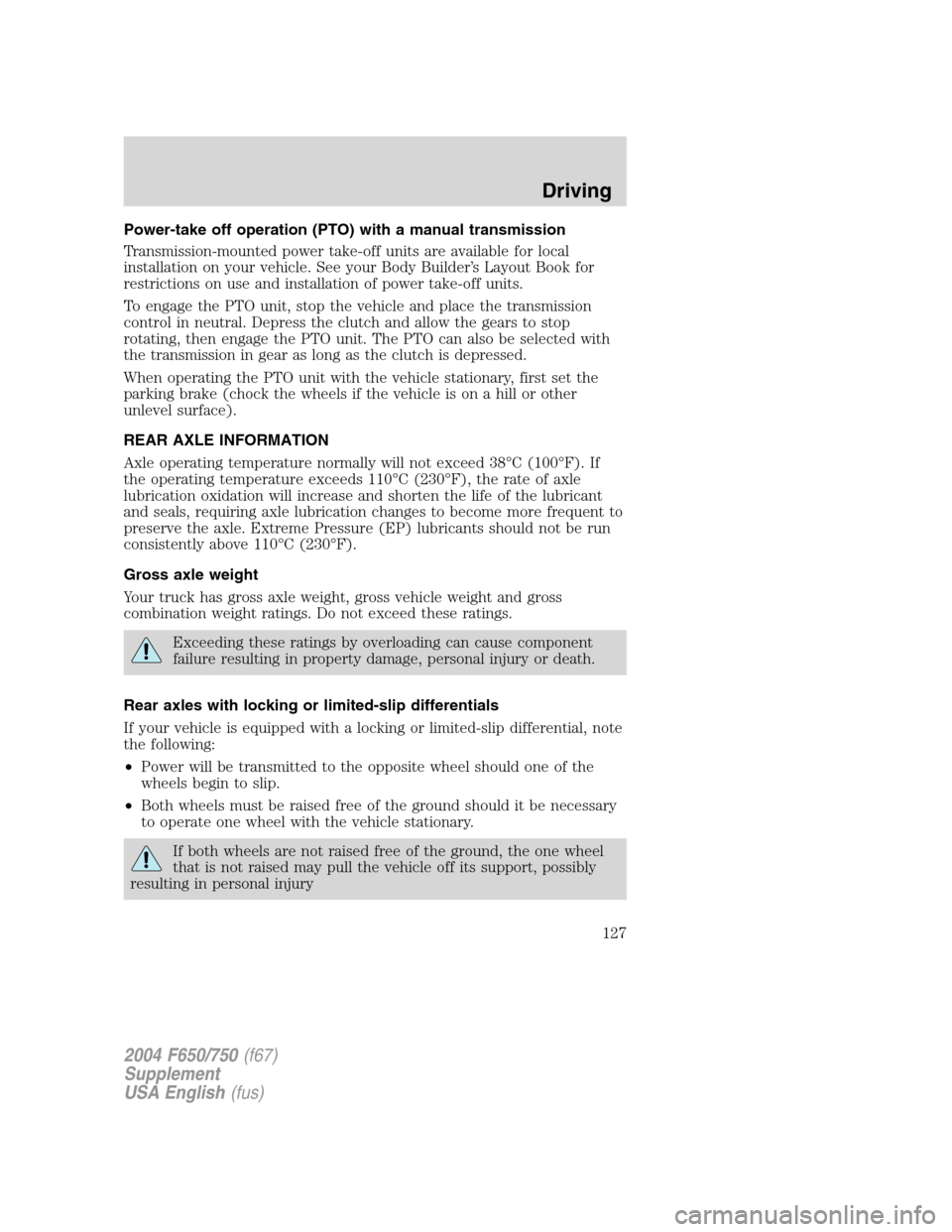
Power-take off operation (PTO) with a manual transmission
Transmission-mounted power take-off units are available for local
installation on your vehicle. See your Body Builder’s Layout Book for
restrictions on use and installation of power take-off units.
To engage the PTO unit, stop the vehicle and place the transmission
control in neutral. Depress the clutch and allow the gears to stop
rotating, then engage the PTO unit. The PTO can also be selected with
the transmission in gear as long as the clutch is depressed.
When operating the PTO unit with the vehicle stationary, first set the
parking brake (chock the wheels if the vehicle is on a hill or other
unlevel surface).
REAR AXLE INFORMATION
Axle operating temperature normally will not exceed 38°C (100°F). If
the operating temperature exceeds 110°C (230°F), the rate of axle
lubrication oxidation will increase and shorten the life of the lubricant
and seals, requiring axle lubrication changes to become more frequent to
preserve the axle. Extreme Pressure (EP) lubricants should not be run
consistently above 110°C (230°F).
Gross axle weight
Your truck has gross axle weight, gross vehicle weight and gross
combination weight ratings. Do not exceed these ratings.
Exceeding these ratings by overloading can cause component
failure resulting in property damage, personal injury or death.
Rear axles with locking or limited-slip differentials
If your vehicle is equipped with a locking or limited-slip differential, note
the following:
•Power will be transmitted to the opposite wheel should one of the
wheels begin to slip.
•Both wheels must be raised free of the ground should it be necessary
to operate one wheel with the vehicle stationary.
If both wheels are not raised free of the ground, the one wheel
that is not raised may pull the vehicle off its support, possibly
resulting in personal injury
2004 F650/750(f67)
Supplement
USA English(fus)
Driving
127
Page 128 of 264

Driver-controlled differential lock
To prevent the vehicle from moving when servicing the wheels, tires or
brakes, turn the engine off and raise all drive wheels of the locker
differential axle. Axles equipped with NoSPIN Detroit Locker differentials
deliver power to both wheels even when only one wheel is on the ground.
Failure to raise all drive wheels with this type of differential
could cause the vehicle to move unexpectedly, resulting in
property damage, personal injury or death.
Care should be taken to avoid sudden accelerations when both drive
wheels are on a slippery surface.
Sudden accelerations on slippery surfaces could cause the
wheels to spin, the vehicle to turn sideways on a crowned road
surface or in a turn, possibly resulting in loss of vehicle control and
personal injury.
Some Dana/Spicer drive axles have a driver-controlled differential lock.
The differential lock can lock or unlock the differential when the vehicle
is moving or stopped. When extra traction is required, the differential
lock will provide full power to both axles.
The differential can be locked or unlocked when the vehicle is moving at
a constant speed of less than 40 km/h (25 mph) and while the wheels
are not slipping. If the differential is locked and vehicle speed exceeds
40 km/h (25 mph), the differential will automatically unlock. Also, the
differential must not be locked when the vehicle is traveling down steep
grades and traction is minimal.
When the differential is locked, the vehicle’s turning radius will increase
(vehicle will“under-steer”)
Axle conversions
It is not recommended, or approved, for axle conversions to be
performed. However, it is understood that, on occasion, aftermarket
add-on axles are installed by others on the truck chassis which allow
operator control for weight transfer from other axles (i.e., air lift axles).
When operating a loaded vehicle, the driver must keep all
adjustable axles on the ground at all times, supporting their
share of the vehicle’s load. Failure to do so can overload other axles,
tires, wheels, springs, steering components, brakes and frames,
resulting in early component failure, loss of vehicle control, possible
property damage and personal injury.
2004 F650/750(f67)
Supplement
USA English(fus)
Driving
128
Page 129 of 264
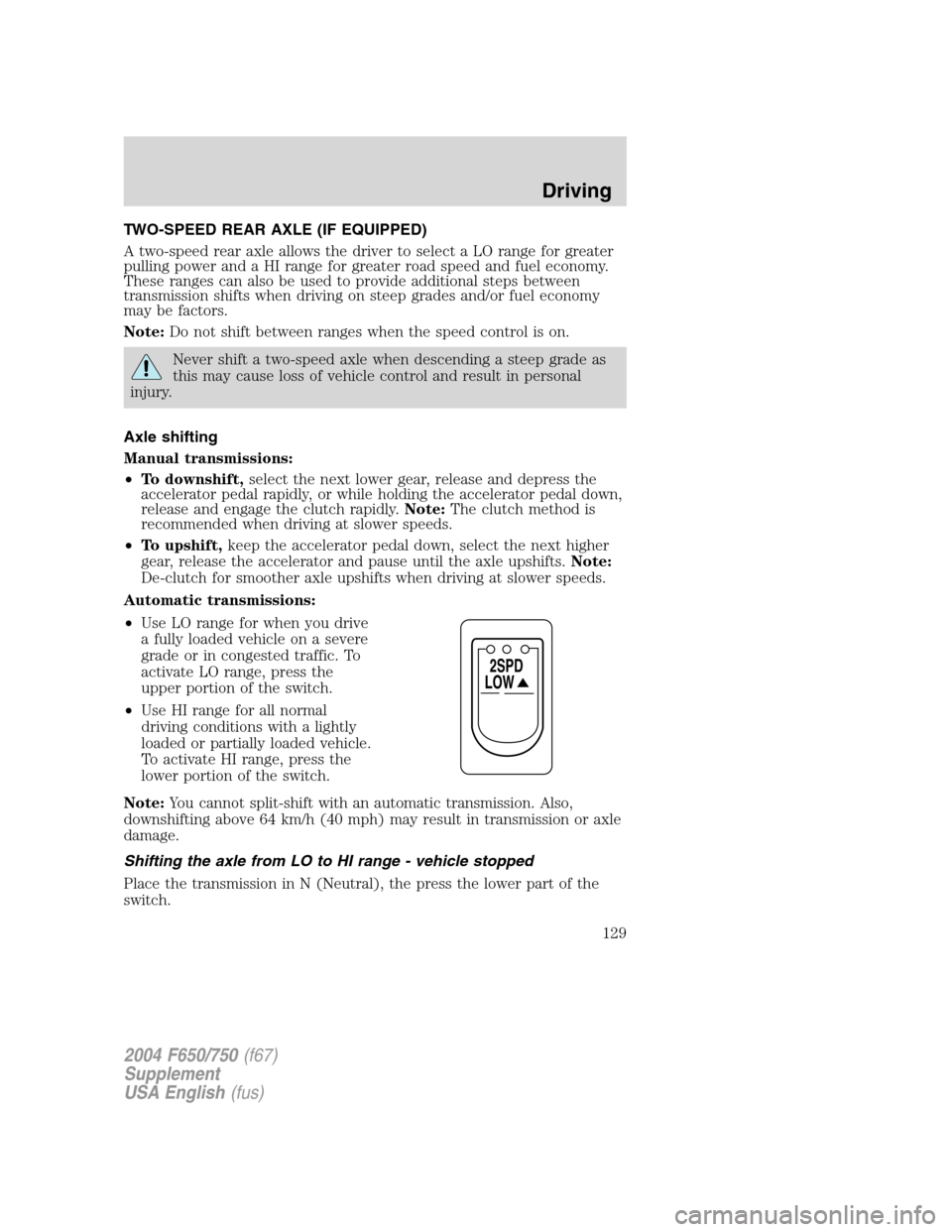
TWO-SPEED REAR AXLE (IF EQUIPPED)
A two-speed rear axle allows the driver to select a LO range for greater
pulling power and a HI range for greater road speed and fuel economy.
These ranges can also be used to provide additional steps between
transmission shifts when driving on steep grades and/or fuel economy
may be factors.
Note:Do not shift between ranges when the speed control is on.
Never shift a two-speed axle when descending a steep grade as
this may cause loss of vehicle control and result in personal
injury.
Axle shifting
Manual transmissions:
•To downshift,select the next lower gear, release and depress the
accelerator pedal rapidly, or while holding the accelerator pedal down,
release and engage the clutch rapidly.Note:The clutch method is
recommended when driving at slower speeds.
•To upshift,keep the accelerator pedal down, select the next higher
gear, release the accelerator and pause until the axle upshifts.Note:
De-clutch for smoother axle upshifts when driving at slower speeds.
Automatic transmissions:
•Use LO range for when you drive
a fully loaded vehicle on a severe
grade or in congested traffic. To
activate LO range, press the
upper portion of the switch.
•Use HI range for all normal
driving conditions with a lightly
loaded or partially loaded vehicle.
To activate HI range, press the
lower portion of the switch.
Note:You cannot split-shift with an automatic transmission. Also,
downshifting above 64 km/h (40 mph) may result in transmission or axle
damage.
Shifting the axle from LO to HI range - vehicle stopped
Place the transmission in N (Neutral), the press the lower part of the
switch.
LOW
2SPD
2004 F650/750(f67)
Supplement
USA English(fus)
Driving
129
Page 130 of 264
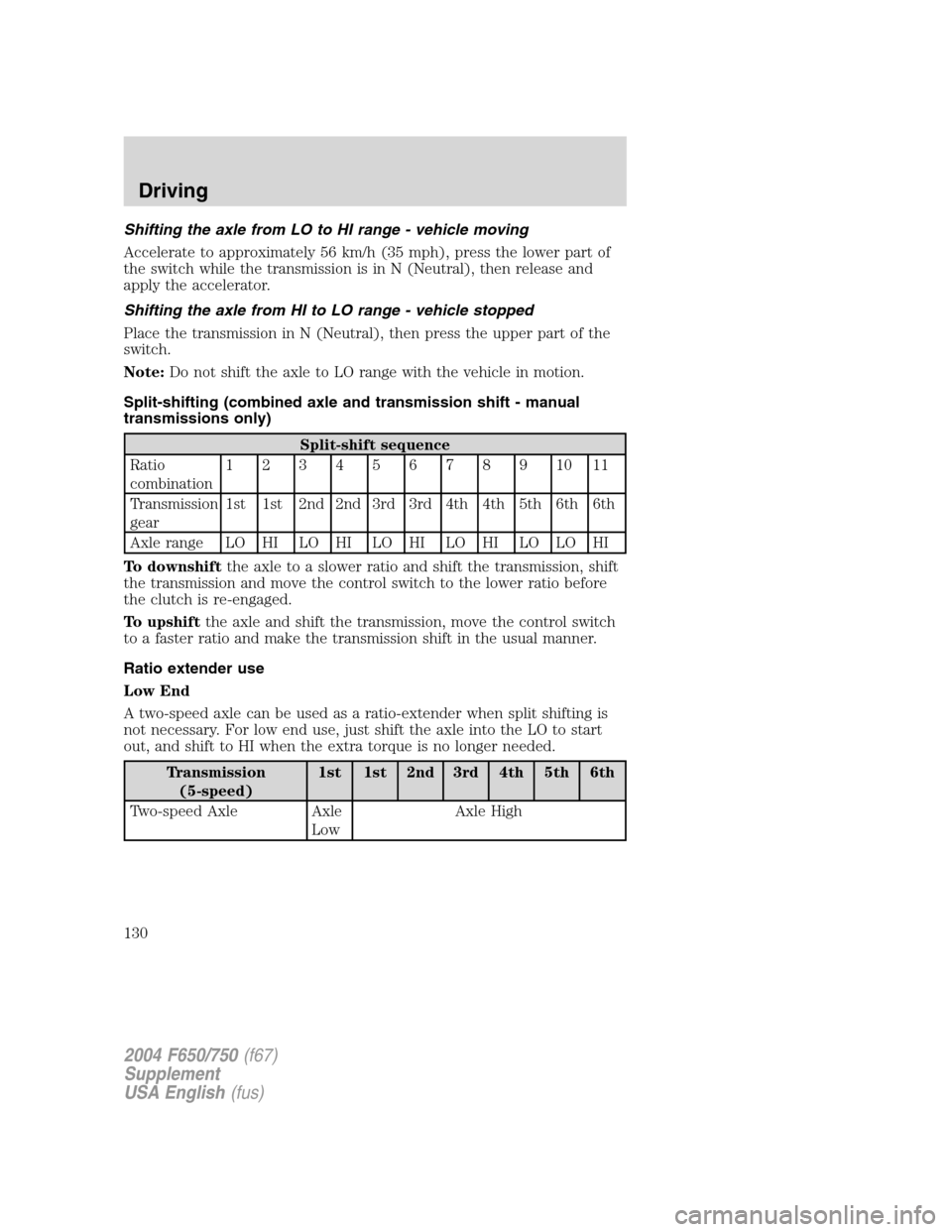
Shifting the axle from LO to HI range - vehicle moving
Accelerate to approximately 56 km/h (35 mph), press the lower part of
the switch while the transmission is in N (Neutral), then release and
apply the accelerator.
Shifting the axle from HI to LO range - vehicle stopped
Place the transmission in N (Neutral), then press the upper part of the
switch.
Note:Do not shift the axle to LO range with the vehicle in motion.
Split-shifting (combined axle and transmission shift - manual
transmissions only)
Split-shift sequence
Ratio
combination1234567891011
Transmission
gear1st 1st 2nd 2nd 3rd 3rd 4th 4th 5th 6th 6th
Axle range LO HI LO HI LO HI LO HI LO LO HI
To downshiftthe axle to a slower ratio and shift the transmission, shift
the transmission and move the control switch to the lower ratio before
the clutch is re-engaged.
To upshiftthe axle and shift the transmission, move the control switch
to a faster ratio and make the transmission shift in the usual manner.
Ratio extender use
Low End
A two-speed axle can be used as a ratio-extender when split shifting is
not necessary. For low end use, just shift the axle into the LO to start
out, and shift to HI when the extra torque is no longer needed.
Transmission
(5-speed)1st 1st 2nd 3rd 4th 5th 6th
Two-speed Axle Axle
LowAxle High
2004 F650/750(f67)
Supplement
USA English(fus)
Driving
130